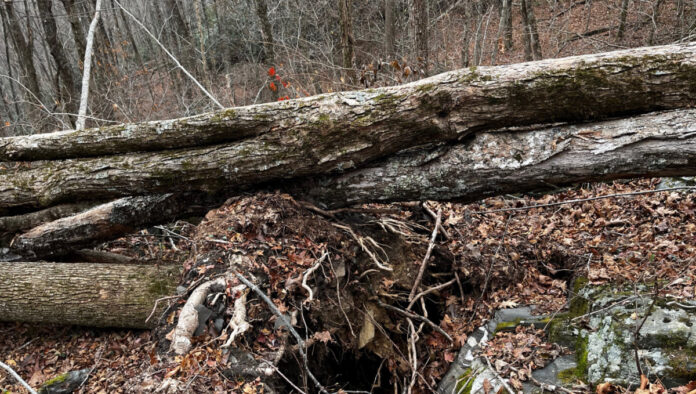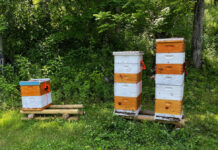On a day last week when it was 8 degrees at 10 a.m., the volunteers from Samaritan’s Purse showed up to cut up some trees Helene had knocked down. In all, they cleared up eight or nine trees. For most, they tossed the logs off the side of the road to roll down the mountain. For the trees closest to the house, the trunks and bigger branches ended up in our pile of future firewood, which is appreciated. When time and weather allow, I will buck them into rounds and split them. The resulting pieces will then dry for a year and we’ll burn them next year to heat the house.
Most of the trees have multiple trunks, so one tree lying across the road means you have to cut a 12-inch trunk and a eight- or ten-inch trunk as well. And since they had no heavy equipment, each trunk had to be cut into pieces small enough that a person can pick them up and move them out of the way.
Because of their work, we now have access to more of our land. They removed the trees that had fallen across, or in two cases down, the old logging road that goes up our mountain, rendering it impassable. Cutting out the fallen trees will allow us to reach our spring and cistern should they need service. It also allowed me to walk up the mountain and ensure the water had not eroded the road to the extent it unburied the pipe from the spring down to the house. It had not. We have had so much cold weather than I consider the lack of frozen pipes a very sign our gravity fed was not damaged by the storm.
Nice Folks
While they were unwilling to tackle the trees that are in the landslide area, I have nothing but good things to say about Samaritan’s Purse. They were better organized and staffed than the last volunteer group that came to help dig us out from under the landslide. Nice people who all got along with each other—no bickering or arguing—with a clear chain of command. There was also no standing around. Everyone came to work. After the work was done, we invited them all inside to eat lunch and warm up.
If you want to support their relief efforts, you will find a link on this page.
Working in the Cold
It never got above 20°F that day, but no one complained. Sawing and lugging logs around will make you build up a sweat in any weather. My knit cap was so sweaty by the time we quit, I had to put on an alternate cap when I went out later that afternoon. No clammy, cold head for me, thank you.
I wore my wool thermal underwear that day and the day before. It has since warmed up enough I can wear my fleece-lined pants instead. I have found no substitute for merino wool long underwear and socks as a base layer on cold days. If you do not own clothing capable of keeping you warm in your winter, you need to invest in some. Just because you don’t plan to go outside doesn’t mean you won’t be forced to in a survival situation.
I have written previously about how I believe your body needs to experience some bitter cold weather to help it adapt to the change from summer to winter. Safe to say I have now had sufficient exposure to have acclimated. When you are walking the dog on a cold windy night, a day of sunshine and 20°F feels warm in comparison. I believe this is why people who live in Alaska and other cold climes are able to function at -43°F. Their bodies are used to it and they dress appropriately.
Ten Weeks and Counting
It has been ten weeks since the storm, but there is much yet to be done, not just here but across Tennessee, North Carolina and Virginia. (I haven’t ben to Georgia or South Carolina, but they may still need help, too.)
While climbing the mountain to clear the trees off the logging road, it became obvious just how many downed trees we have as a result of Helene. The number is beyond count, but well into the hundreds. We will never clear them all, nor do I expect to try. Most of those trunks and root balls will be there until they rot, which the U.S. Forest Service estimates will take 46 to 71 years. Even though I expect our rainy climate means they will rot away on the lower end of that range, I expect the fallen trees will outlast me.
Downed Trees are here to Stay
I have concluded our rocky soil contributed to the trees falling and to the landslides. In many cases, the topsoil over a boulder or piece of bedrock was not that deep, maybe only a foot. That didn’t give the tree’s roots much to grab onto. As a result, a hurricane-force wind would knock a tree over, leaving a root ball sticking into the air and a piece of rock revealed below.
As often as not, one tree fell on another, causing it to topple as well. Sometimes, the fallen trees are layered with their trunks and limbs intertwined and locked together. If I were trying to prevent someone from climbing up the mountain, I would have a hard time making a better blockade. I expect the size and length of the downfalls and the steepness of the hill would combine to stop a bulldozer.
In some cases, trees that were more firmly rooted snapped in the middle. This is seen most often with pine trees, but there are examples of others where the tree snapped somewhere between 12 and 40 feet in the air. The tops of the pines often crashed to the ground while the hardwoods sometime have their tops hanging on a hinge. The recent high winds of the cold front moving through knocked down more than a few of these tree heads. The idea that anything left from the storm would have “proven” itself and be strong enough to withstand whatever came next proved to be incorrect. We have had the power outages—including one yesterday—to prove it.







